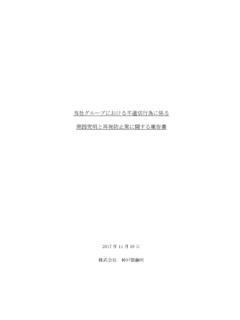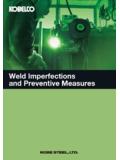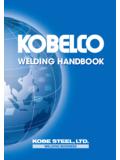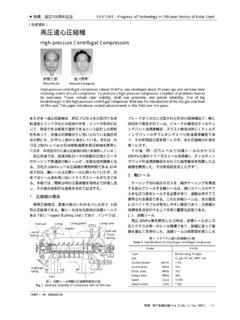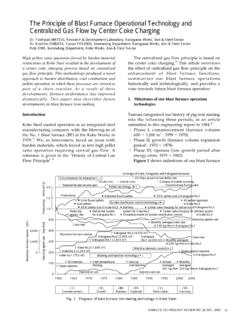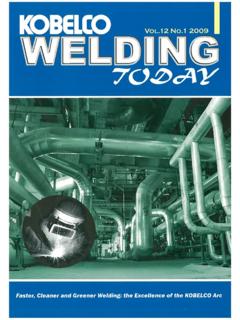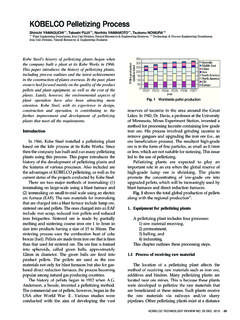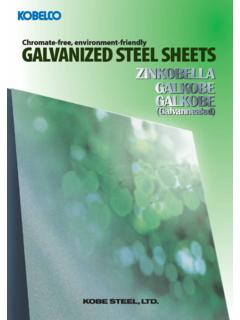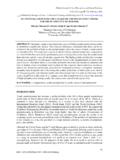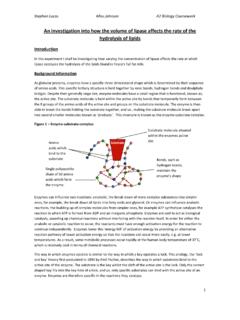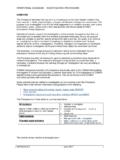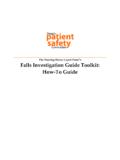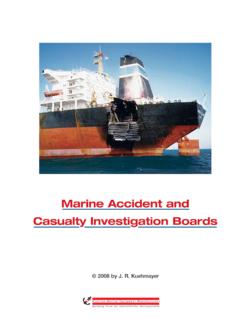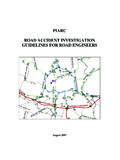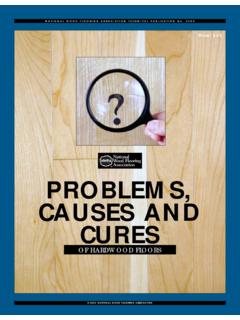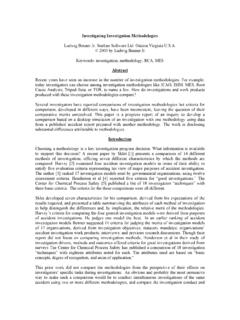Transcription of Report on investigation into the causes of the Kobe Steel ...
1 Report on investigation into the causes of the Kobe Steel Group's improper conducts and on measures to prevent recurrence November 10, 2017. Kobe Steel , Ltd. Table of contents Page 1. Introduction 2. 2. Background 3. 3. Outline and activities of the Quality Issue investigation Committee 6. 4. Public announcements to date <Attachment (i)>. 8. 5. Progress of communications with customers and safety verification 8. 6. Explanations on improper incidents made public so far 9. (1) Explanation on improper incidents <Attachment (ii)>. (2) Classification of incidents of misconduct based on business location (3) Classification of incidents of misconduct based on type of misconduct 7. Analysis of cause 12. 8. Preventive measures 17. 9. Establishment of an Independent investigation Committee 23. <Attachments>. (i) Facts publicly announced so far 25. (ii) Explanations on improper incidents made public so far 26. (iii) List of business locations where quality self-inspection was 31.
2 Conducted 1. 1. Introduction _____. We sincerely and deeply apologize for the enormous trouble we have caused to our customers, suppliers, shareholders and others in respect of the improper conducts by our company and our group companies. _____. After Shinko Wire Stainless Co., Ltd. (a wholly-owned subsidiary of Shinko Wire Company, Ltd., one of our equity-method affiliates), a company in our Iron & Steel Business, was found in violation of the Industrial Standardization Act (the JIS Act ) in June 2016, our head office, in April of this year, launched a quality audit of the manufacturing facilities and service locations in the Kobe Steel Group, with the audit scope being extended to examining compliance with customer specifications in addition to the mandatory standards concerning product quality set forth in laws and regulations ( Mandatory Standards ). Early in August, we also requested the entire Group to conduct, beginning in September, a self-inspection of the products shipped during the past one year period.
3 In response, the Aluminum &. Copper Business started part of its inspection activities ahead of the schedule and, at the end of August, detected its improper handling of test data. Our self-inspection, which was generally completed on October 25, has confirmed so far that multiple business locations were engaged in inappropriate conducts. While we believe that our self-inspection was effective in detecting inappropriate conducts, we encountered interference at the extrusion plant in the Chofu Works during the inspection. This incident made us aware of the limits of our self-inspection. Accordingly, we established the Independent investigation Committee on October 26. There were differences among the inappropriate conduct cases uncovered by the inspection, depending on the types of products, manufacturing systems, and the sizes of plants. However, there were cases where the employees of multiple departments such as a manufacturing department and a quality assurance department were involved, and those where such misconducts continued for a long period.
4 We believe that what is most important in our deliberation of measures to prevent recurrence is to analyze the characteristics of those misconducts and find out the reasons why they happened and why they have gone undetected for such an extended period. The fact that the management has failed to detect and deal with such major infractions that happened at the plant level is itself a significant issue. We recognize that it is the management's responsibility to find out the real causes for these misconducts, and formulate and implement measures to prevent such infractions from recurring. With that recognition, we established a task force ( , Cause investigation TF) and conducted investigation and analyses. Our analyses of the causes of the confirmed misconducts led us to conclude that the following five factors are the causes for those inappropriate conducts. 1) Management propensity to overemphasize profitability and the insular organizational culture 2. 2) Imbalanced operation of manufacturing facilities 3) Inadequate quality control processes that permitted improper conducts 4) Reduced awareness for the need to strictly comply with contractual specifications 5) Inadequate organizational system Based on our analyses of the causes for the inappropriate conducts, we have decided to adopt measures to address management propensity to overemphasize profitability and the insular organizational culture, by such means as the establishment of a Quality Charter and sufficient opportunities to have dialogues between the management and employees.
5 We will also take process-related measures and management-related measures. Process-related measures will reform system and business processes which provided opportunities for inappropriate conducts. Management-related measures include a clear segregation of the quality control function from the quality assurance function, strengthening of each of those functions, and establishing a quality assurance department under the direct control of each business unit. Furthermore, the head office will establish a Quality Audit Department (as it is tentatively named), which will be dedicated to quality audit for the purpose of strengthening quality governance. It will also have the Quality Governance Restructuring Deliberation Committee (established on November 10). consider measures to strengthen quality governance of Group companies, organizational reforms, and awareness reforms, use of external talents, and reinforcement of the functions of the overseas holding companies, among others.
6 Besides the planned measures described above, we will have the Quality Governance Restructuring Deliberation Committee deliberate a series of measures based on a Report that the Independent investigation Committee is aiming to provide to the board of directors around the end of the year. The outcomes of the discussions in the Quality Governance Restructuring Deliberation Committee will be reflected in final preventive measures. 2. Background After Shinko Wire Stainless Co., Ltd. (a wholly-owned subsidiary of Shinko Wire Company, Ltd., one of our equity-method affiliates), a company in our Iron & Steel Business, was found in violation of the JIS Act in June 2016, we conducted a Group-wide inspection with respect to the Mandatory Standards. Thereafter, the Iron & Steel Business further reinforced the quality audit system, and expanded the audit scope to include sub-subsidiaries. In addition to performing audit work under the previously-used methods, the Iron & Steel Business decided to compare the data on test reports with raw test data as an audit of actual goods.
7 We also reinforced the audit of our overseas Group companies. An external expert (JMA Consultants Inc.) has advised that there is no inappropriate procedure in our methods of quality audit of the Group companies, including Kobe Steel , Ltd. itself. 3. Meanwhile, the Kobe Steel Group established the Quality Management Section in the head office's MONODZUKURI (Product Manufacturing) Planning and Promotion Department in November 2016 to strengthen the quality control system, especially quality audit, and in April 2017 commenced quality audit of the Kobe Steel Group's compliance with customer specifications as well as Mandatory Standards. We also required early in August that, for two months starting from September, the entire Group conduct a self-inspection of records for the products shipped in the past one year period. In response, the Aluminum & Copper Business started part of its inspection ahead of the schedule and, at the end of August, detected its improper handling of test data.
8 After the misconducts were detected, the Aluminum & Copper Business as an initial step immediately ceased shipping nonconforming products, while the staff of the head office and outside counsel investigated the inappropriate conducts and, on September 12, reported the results to the Management Council. After the Management Council's meeting, we established four task forces (TF) under the President: the Emergency Audit TF, the Customer Support TF, the Cause investigation TF, and the Public Announcement TF. We also started activities such as an emergency audit, to confirm whether the self-inspection was conducted in a proper manner. On September 25, the Quality Issue investigation Committee took over the four TFs, and conducted each task force's activities. The self-inspection was generally completed on October 25, and the Independent investigation Committee was established on October 26. 8/E Misconducts detected at four locations of the 8/E Delivery of nonconforming products stopped Aluminum & Copper Business 9/1 Group-wide self-inspection started 9/B investigation by the head office's staff and external counsel 9/12 investigation results reported to Management Council 9/12 Four TFs established under the President 9/12 Emergency Audit TF, Customer Support TF, Cause investigation TF.
9 And Public Announcement TF established 9/25 Four TFs taken over by the Quality Issue 9/25 Deliberated at Management Council investigation Committee 9/28 Interim results reported to Board of Directors 10/8- Public announcement 10/10 Progress reported to Board of Directors 10/17 Progress reported to Board of Directors 10/24 Progress reported to the Compliance Committee 10/25 Self-inspection generally completed 10/25 Deliberated at Management Council 10/26 Independent investigation Committee formed 10/26 Resolved at Board of Directors 10/26 Interim Report at extraordinary Compliance Committee meeting [Fig. 2-1 Main events from the detection of the misconducts up until the establishment of the Independent investigation Committee]. 4. <Outline of self-inspection and emergency audit>. (i) Purpose of self-inspection: Confirm if any inappropriate conduct has taken place within the Kobe Steel Group (ii) Target of self-inspection: A total of 100 locations at which our Group conducts manufacturing activities or provides inspection and testing services: 21 locations of Kobe Steel , Ltd.
10 , 55 locations of domestic Group companies, and 34 locations of overseas Group companies (Please refer to Attachment 3 for more details on locations.). (iii) Period covered by self-inspection: One year from September 2016 to August 2017. (iv) Specific methods of self-inspection: Check by comparing real data: Compare test reports with test data Compare specifications required by customers with the company's instructions on testing *1: Departments which do testing or decide whether to ship products refrained from taking part in self-inspection as much as possible. In cases they needed to participate in the self-inspection, they had other departments involved in the self-inspection to ensure objectivity. *2: We received from JMAC its advice that our inspection methods were reasonable. (v) Emergency audit: The head office conducted an emergency audit to make sure that the self-inspection had been properly conducted. 5. 3. Outline and activity of the Quality Issue investigation Committee (1) The position of the committee In response to the Shinko Wire Stainless Company, Ltd.

